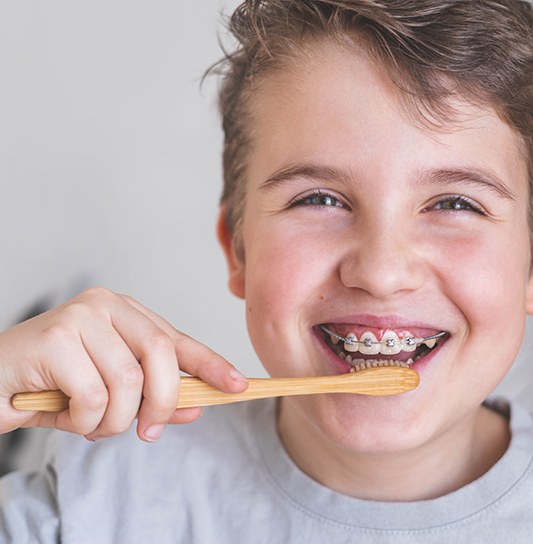
Traditional Braces – Cumming, GA
A Reliable Way to Realign Your Child’s Grin
Did you know that crooked or gapped teeth can impact your child’s appearance and dental health? Fortunately, Dr. Podray-Donovan has a reliable way to realign your child’s grin. Standard braces are the tried-and-true method of straightening smiles because they can address everything from simple cases to more severe misalignments of the mouth and jaw. Continue reading to learn more about traditional orthodontics, and feel free to contact us with additional questions.
Why Choose Village Pediatric Dentistry for Traditional Braces?
- Skilled Orthodontist with 10+ Years of Experience
- Advanced Technology to Enhance Patient Comfort
- Vice President of the Georgia Association of Orthodontists
How Do Traditional Braces Work?

To straighten your child’s smile with braces, Dr. Podray-Donovan bonds metal brackets to their front surface. Then, she threads these with an archwire that can be tightened or loosened as needed to exert the right amount of pressure to move them. Your child will need a follow-up visit every 6 to 8 weeks to make necessary adjustments. Depending on the severity of their condition, treatment can take 18 months to a few years.
What Orthodontic Issues Can Braces Fix?

Before your child can get braces, you must schedule a consultation with Dr. Podray-Donovan. She’ll examine their dental condition and provide recommendations for solutions based on her findings. Some potential issues that can often be resolved with traditional orthodontics include:
Bite Misalignment
If your kid’s teeth don’t meet in the appropriate places when they relax their jaw, they might have a bite misalignment, also called malocclusion. For instance, if their upper arch extends too far beyond their lower one, they may suffer from an overbite.
Unfortunately, these conditions can wear down their enamel unevenly or prematurely, leaving their teeth more vulnerable to cracks, chips, and other injuries. They can also cause TMJ (temporomandibular joint) disorders that lead to a stiff or locked jaw.
Braces, bands, and elastics can reposition your child’s jaw and resolve the problem.
Crowded & Crooked Teeth
Teeth that overlap or are pressed too closely together can be problematic because they’re difficult to clean. When you can’t easily access all their sides, brushing and flossing them thoroughly is hard. As a result, plaque and tartar can accumulate and lead to cavities or gum disease.
Shifting your child’s teeth with braces creates a uniform appearance while allowing them to build and maintain a more consistent daily dental hygiene routine.
Gapped Teeth
Wide spaces in your kid’s smile can be just as harmful as overcrowding for a couple of reasons. Firstly, gaps are notorious for trapping bits of food that attract disease-inducing bacteria. On top of that, they leave more of the gum tissue exposed, which can lead to lacerations, infection, or gingivitis.
Bringing their teeth closer together can prevent these potential problems.
Caring for Your Child’s Braces

Because your child’s braces will be a permanent fixture on your child’s teeth throughout their treatment, you’ll need to help them learn to take good care of them. They need to continue to brush and floss regularly but might need special brushes and floss threaders that can reach around the metal brackets. Also, discourage them from eating overly hard, crunchy, or sticky foods that could break the brittle metal or yank one off a tooth.
Also, don’t forget to take your child to see their provider regularly to ensure their treatment stays on track!